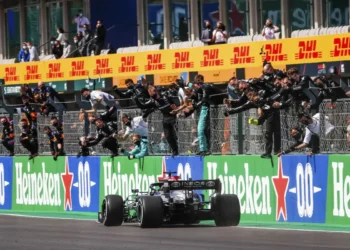The 2024 Formula 1 season wasn’t just a test of driver skill and engineering prowess—it was also a financial chessboard, with teams shelling out millions for top talent while chasing championship glory. But how much did each driver truly cost their team for every point they delivered? The results are as fascinating as the battles on track.
This analysis breaks down the cost-per-point for each driver, revealing who delivered value and who left teams questioning their investments. From Max Verstappen’s championship dominance to struggles at the back of the grid, the disparity is striking.
Top 10 Highest Paid F1 Drivers in 2024
Here’s how the big earners lined up, with salaries and bonuses making up their total earnings:
| Driver | Base Salary | Bonuses | Total Earnings |
|---|---|---|---|
| Max Verstappen | $60M | $15M | $75M |
| Lewis Hamilton | $55M | $2M | $57M |
| Lando Norris | $12M | $23M | $35M |
| Fernando Alonso | $24M | $3.5M | $27.5M |
| Charles Leclerc | $15M | $12M | $27M |
| George Russell | $15M | $8M | $23M |
| Oscar Piastri | $5M | $17M | $22M |
| Sergio Perez | $12M | $7.5M | $19.5M |
| Carlos Sainz Jr. | $10M | $9M | $19M |
| Pierre Gasly | $10M | $2M | $12M |
How Does “Cost Per Point” Work?
This simple metric divides a driver’s total earnings by the points they scored across the season. While it doesn’t account for a driver’s intangible contributions—such as leadership, car development feedback, or marketing impact—it provides a clear snapshot of their cost-effectiveness.
Big Winners and Costly Disappointments
1. Max Verstappen ($171,458 per point)
With a staggering 437 points scored, Verstappen’s $75M paycheck still makes him one of the most cost-efficient top earners. His dominance meant Red Bull maximized their ROI, even if they fell short in the Constructors’ standings.
2. Lando Norris ($130,000 per point)
Norris was a steal for McLaren at $35M total earnings. As the vice-champion, Norris delivered consistent podiums and wins, proving he’s worth every penny—and then some.
3. Oscar Piastri ($140,000 per point)
The rookie sensation stunned the paddock with his stellar debut season. For just $22M, Piastri helped McLaren secure their Constructors’ title, making him a bargain compared to more experienced rivals.
4. Lewis Hamilton ($370,000 per point)
The seven-time world champion struggled with an inconsistent Mercedes, and his $57M salary came under scrutiny. With only 154 points, Hamilton’s cost-per-point was significantly higher than that of his younger teammate, George Russell.
5. Sergio Perez ($960,000 per point)
Perez’s poor season compounded Red Bull’s Constructors’ woes. Scoring just 152 points, Perez’s cost-per-point nearly hit the $1M mark, leaving questions about his future with the team.
6. Fernando Alonso ($220,000 per point)
Alonso proved age is just a number, scoring consistently for Aston Martin despite the team’s mid-season slump. His $27.5M earnings seem justified given his overall contribution.
What the Numbers Don’t Tell
While cost-per-point is a compelling metric, it doesn’t paint the full picture. Drivers like Hamilton and Alonso bring invaluable experience to their teams, aiding car development and mentorship. Similarly, Verstappen’s dominance doesn’t just win races—it elevates Red Bull’s brand globally.
On the flip side, high-cost drivers like Perez and Hamilton will face mounting pressure to justify their paychecks if their performances don’t align with expectations.
Looking Ahead to 2025
The 2024 numbers reveal a clear message: teams are under pressure to balance budgets and performance more than ever. With McLaren emerging as a championship-winning powerhouse and Red Bull facing internal shake-ups, the financial dynamics of Formula 1 promise to be just as intense as the on-track rivalries.
One thing’s certain: in the world of Formula 1, every point has a price, and every paycheck is a gamble.










